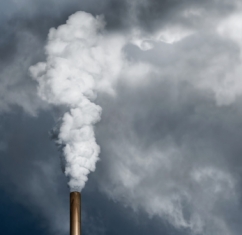
By Laurie Johnson. Posted on the Natural Resources Defense Council's Switchboard blog. September 13, 2010.
With stalled clean energy legislation in DC, opponents of environmental protection have shifted their focus away from pro-active legislation toward dismantling existing environmental protection laws. Against the Supreme Court’s mandate, industry-funded politicians and the lobbyists that support them (e.g. National Association of Manufacturers (NAM)) are trying to prevent the Environmental Protection Agency (EPA) from doing its job: requiring polluters to reduce global warming pollution. Predictably, they are making the same argument they’ve always made—one that’s never come true: “Protecting the environment will destroy jobs; it will be impossible for firms to meet any new requirements and stay in business at the same time.”
On three counts (and there are many more), the facts simply do not substantiate this dangerous politics of fear:
1. There is a positive relationship between job growth and environmental protection.
As I’ve documented many times, decades of environmental protection laws demonstrate that pitting jobs against the environment presents a false choice (click here and here). In fact, as EPA approaches its 40th birthday (December 2, 2010), we can celebrate an economy with a GDP 3 times its 1970 size, household incomes that are on average 45% higher, the creation of tens of thousands of jobs in the environmental protection industry, and tens of thousands of lives saved from a cleaned up environment. At the same time, regulated power plants’ electricity rates declined, contrary to industry and even EPA forecasts. A compelling new study on recent regulation on coal-fired power plants tells the exact same story (click here for a summary and analysis).
2. Industry hyperbole aside, the EPA has historically only required emission controls where they are available and affordable, and only on large source polluters.
For decades, EPA has a proven track record of implementing regulations that work, and there is no reason to expect they won’t work for greenhouse gases as well.
3. Current controls on carbon emissions at the state level are creating jobs, reducing energy bills, and lowering carbon emissions.
Forging ahead in the absence of Federal leadership, some states have already begun charging polluters for their emissions, using the revenues to invest in clean energy solutions and energy efficiency—putting people to work, saving taxpayer dollars and creating new small business opportunities. Under an agreement called the Regional Greenhouse Gas Initiative (RGGI), a group of Mid-Atlantic and Northeast states have so far raised $308 million, and used the proceeds to help homes and businesses expand energy efficiency programs. The result: consumers saved more than $900 million across the RGGI region. What’s more, these programs drove energy prices down (hmm, sound familiar?), as lower energy consumption reduced wholesale electric prices by 40-50%. And, perhaps most importantly, RGGI has promoted pollution control programs that have cost-effectively reduced carbon pollution by about 30% from business-as-usual. For more detail, click here, here and here for more RGGI success stories.
The bottom line:
Every line of evidence points to the same conclusion. Allowing EPA to do what it is legally required to do (protect public health from dangerous pollution) will not cost us jobs or damage the economy. In fact, there’s every reason to believe the opposite.
This post originally appeared on NRDC's Switchboard.
Laurie Johnson is Chief Economist at the Climate Center of the Natural Resources Defense Council in Washington DC. Prior to joining the NRDC in May 2008, Johnson was a professor in the economics department at the University of Denver for eight years. Her research in environmental and natural resource economics, experimental economics, and poverty and welfare, appeared in academic and popular journals. At NRDC, Johnson's work has focused on macroeconomic modeling of climate change legislation, as well its distributional impacts. She received her PhD in economics from the University of Washington, Seattle.


Add new comment